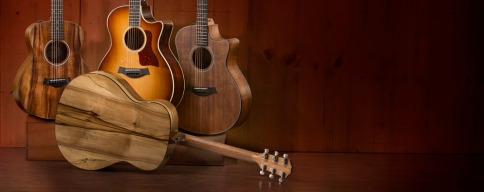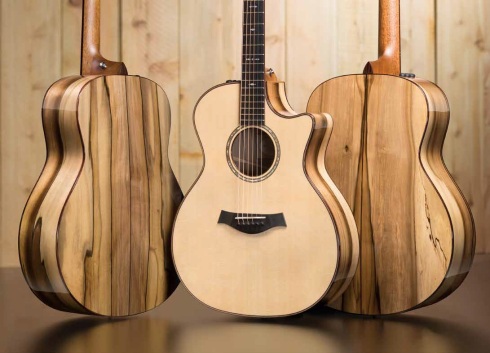
For the past few years Taylor Guitars have been heavily promoting Tasmanian blackwood as the great new sustainable tonewood.
But it seems the promotion plan has come off the rails.
This commentary is speculative but from what I know it fits the available evidence.
After the big release by Taylor of the 2014 Fall Limited Edition (FLE) models things appear to have come unstuck.
https://www.taylorguitars.com/guitars/limited-editions/fall-2014
https://blackwoodgrowers.com.au/2014/08/02/taylor-guitars-put-tasmanian-tonewoods-on-display/
https://blackwoodgrowers.com.au/2014/10/05/island-roots/
The Taylor 2014 FLE models put Tasmanian blackwood up against some serious competition in the way of Hawaiian koa and Tasmanian black heart sassafras, and without too much surprise, the competition appears to have won this race at least.
Sales of the koa and sassafras models were apparently so good that the all koa GS mini is now part of the standard GS mini range. Taylor then came back to Tasmania for a second order of sassafras timber which has now been included in the 2015 Summer Limited Edition (SLE) models.
https://www.taylorguitars.com/news/2015/07/06/taylor-guitars-debuts-stunning-quilted-sapele-curly-mahogany-and-blackheart
https://www.taylorguitars.com/guitars/acoustic/714ce-s-ltd
https://www.youtube.com/watch?feature=player_detailpage&v=zZyNsP-_hVU#t=235
No such joy for Tasmanian blackwood however. Clearly the 2014 FLE blackwood models failed to ignite the market.
Without too much hindsight this result isn’t a surprise.
The fact that the Winter 2015 Wood & Steel magazine from Taylor had a major focus on future tonewood supply but made no mention of Tasmanian blackwood, reinforces the likelihood that Taylor have shifted the focus away from blackwood.
https://www.taylorguitars.com/sites/default/files/Wood-Steel_Winter-2015_EN.pdf
Don’t get me wrong. I think Taylor Guitars are a great company and they make fantastic guitars. But everyone makes mistakes. I’m no marketing expert but here’s why I think the Tasmanian blackwood models failed to fire the market:
Too much serious competition
Of the four styles on offer for the 2014 FLE models, the blackwood models were by far the plainest and least visually appealing. Two of the models featured koa which is a well established quality tonewood in the American market. The Tasmanian blackheart sassafras, whilst new to the international commercial guitar market, was just so visually stunning and unique. Without any tonal heritage sassafras stole the show like a supermodel on the catwalk. Do I guess the premium acoustic guitar market is dominated by men? But who can blame them for being visual slaves. Of course not everyone wants a visually stunning guitar. Some people prefer the plain and unadorned. But that’s definitely not the dominant market.

Product development and design.
Even ignoring the competition the blackwood design in the 2014 FLE lineup was just ordinary especially by Taylor’s very high standards. Taylors have a very strong sense of the aesthetic. So what happened?
If Taylor uses the limited editions to test new products in the marketplace then the 2014 FLE models merely reinforced existing market preferences for the rare, the visually stunning, and the familiar. In terms of pushing Tasmanian blackwood into the international tonewood market it failed.
So how do you introduce Tasmanian blackwood to the international tonewood market?
How do you introduce a plain grain premium tonewood to a market addicted to feature grain and visual appeal?
Here are some ideas:
- Don’t introduce the product in competition with other products that already have an obvious market advantage;
- a clear price differential is needed between plain and feature grain to reflect the fact that feature grain tonewood is a rare commodity;
- if market resistance to new product is expected/encountered then perhaps introduce the product at a lower price bracket. If the product is good it will quickly move up into the premium market;
- if introducing a new “plain” product into a premium market then extra effort is needed in product design, development and marketing.
Tasmanian blackwood has the potential to become an internationally recognised profitable, sustainable, premium tonewood but the road ahead remains uncertain.
I hope one day Taylor Guitars come back to Tasmanian blackwood.
Ooops! Not such a success
For the past few years Taylor Guitars have been heavily promoting Tasmanian blackwood as the great new sustainable tonewood.
But it seems the promotion plan has come off the rails.
This commentary is speculative but from what I know it fits the available evidence.
After the big release by Taylor of the 2014 Fall Limited Edition (FLE) models things appear to have come unstuck.
https://www.taylorguitars.com/guitars/limited-editions/fall-2014
https://blackwoodgrowers.com.au/2014/08/02/taylor-guitars-put-tasmanian-tonewoods-on-display/
https://blackwoodgrowers.com.au/2014/10/05/island-roots/
The Taylor 2014 FLE models put Tasmanian blackwood up against some serious competition in the way of Hawaiian koa and Tasmanian black heart sassafras, and without too much surprise, the competition appears to have won this race at least.
Sales of the koa and sassafras models were apparently so good that the all koa GS mini is now part of the standard GS mini range. Taylor then came back to Tasmania for a second order of sassafras timber which has now been included in the 2015 Summer Limited Edition (SLE) models.
https://www.taylorguitars.com/news/2015/07/06/taylor-guitars-debuts-stunning-quilted-sapele-curly-mahogany-and-blackheart
https://www.taylorguitars.com/guitars/acoustic/714ce-s-ltd
https://www.youtube.com/watch?feature=player_detailpage&v=zZyNsP-_hVU#t=235
No such joy for Tasmanian blackwood however. Clearly the 2014 FLE blackwood models failed to ignite the market.
Without too much hindsight this result isn’t a surprise.
The fact that the Winter 2015 Wood & Steel magazine from Taylor had a major focus on future tonewood supply but made no mention of Tasmanian blackwood, reinforces the likelihood that Taylor have shifted the focus away from blackwood.
https://www.taylorguitars.com/sites/default/files/Wood-Steel_Winter-2015_EN.pdf
Don’t get me wrong. I think Taylor Guitars are a great company and they make fantastic guitars. But everyone makes mistakes. I’m no marketing expert but here’s why I think the Tasmanian blackwood models failed to fire the market:
Too much serious competition
Of the four styles on offer for the 2014 FLE models, the blackwood models were by far the plainest and least visually appealing. Two of the models featured koa which is a well established quality tonewood in the American market. The Tasmanian blackheart sassafras, whilst new to the international commercial guitar market, was just so visually stunning and unique. Without any tonal heritage sassafras stole the show like a supermodel on the catwalk. Do I guess the premium acoustic guitar market is dominated by men? But who can blame them for being visual slaves. Of course not everyone wants a visually stunning guitar. Some people prefer the plain and unadorned. But that’s definitely not the dominant market.
Product development and design.
Even ignoring the competition the blackwood design in the 2014 FLE lineup was just ordinary especially by Taylor’s very high standards. Taylors have a very strong sense of the aesthetic. So what happened?
If Taylor uses the limited editions to test new products in the marketplace then the 2014 FLE models merely reinforced existing market preferences for the rare, the visually stunning, and the familiar. In terms of pushing Tasmanian blackwood into the international tonewood market it failed.
So how do you introduce Tasmanian blackwood to the international tonewood market?
How do you introduce a plain grain premium tonewood to a market addicted to feature grain and visual appeal?
Here are some ideas:
Tasmanian blackwood has the potential to become an internationally recognised profitable, sustainable, premium tonewood but the road ahead remains uncertain.
I hope one day Taylor Guitars come back to Tasmanian blackwood.
Share this:
Like this:
Related
FOLLOW BLOG VIA EMAIL
FOLLOW BLOG VIA EMAIL
Categories